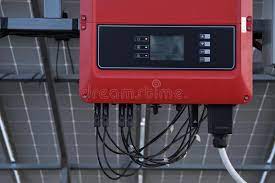What is a power factor controller?
The power factor controller is an electronic device which tries to match the power factor value while keeping an eye on the reactive power generated by the power plant. It is a box enclosing electronic circuitry with a menu-driven interface and plain text display for operations. Since reactive power load is increasing in today’s complex energy systems, heat is constantly increasing.
Controlling rising reactive loads is becoming necessary, and that is where reactive power controllers come into effect. It works by switching capacitors to achieve a user-specified cos ɸ. The power factor controller enables process optimization, accelerated troubleshooting, and cost savings for the supervised systems.
While keeping track of the power plant’s reactive power, the power factor controller tries to match the power factor value.The power factor value is the perceived power (W) ratio to the active power (VA).
The job of the power factor controller is to permanently monitor the installed reactive power and control the power factor.
This article will cover all the information a technician might want about power factor controllers, like their different types, uses, working of power factor controllers, applications in different industries, and advantages and disadvantages.
Factors you consider when selecting a power factor controller
Below are some of the parameters a person should consider before choosing the proper power factor controllers devices for this industry’s needs;
- We need to take the number of capacitors into account.
- Simple to install.
- The meal needs to be approachable.
- There ought to be several language choices.
- The power supply should have a feature to vary its voltage levels.
- It’s critical to have both automated and manual options available.
- Harmonics from the electricity shouldn’t have any effect.
- There should be opportunities for communication if communication is necessary.
- The output of an alarm is required.
- Save the settings.
- Economic costs for energy are reduced as a result of installing a power factor controller.
How do power factor controllers work?

The Power Factor Controller has a more straightforward working method. As soon as the power factor decreases, the microcontroller starts monitoring the power factor of the power line in real time. Normally, a signal instructing the thyristor to connect the capacitor bank to the power line is sent to it. The computer again instructs the thyristor to disconnect the capacitor bank when the power factor exceeds the required level.
Types of power factor controllers
There are two main types of power factor controllers available in the market, namely;
- Passive PFCs
- Active PFCs
Passive Power Factor Controllers
Poor power factors are corrected by a filter at the AC input in a passive PFC. The simplest form of power factor controller is passive. These PFCs have two other types: Capacitor input filter and Valley-fill PFCs. A passive PFC corrects weak power factors using passive components (e.g., inductors and capacitors). Power factor is adjusted via passive PFC to 0.7–0.85. Only passive parts are used in the passive PFC circuitry.
Active Power Factor Controllers
A passive PFC circuit is more larger and heavier than an active PFC circuit, which also gives better THD. When using power supplies that are over 100W, the active PFC is preferred. MOSFETs, BJTs, and IGBTs are used in active electronics circuits, which are used in active PFCs. As technology advances, designers of electronic/power supplies can build circuits with various modes of operation and unique problems. Here are two basic active PFCs: Boost design and a Buck design PFC.
Read More about ‘Furnace Troubleshooting’ in this article: Furnace Troubleshooting: Seven Common Problems and Simple Solutions In Detail available in our ‘Tech’ category
Advantages and Disadvantages of power factor controller
Advantages
The following are the main advantages of the power factor controller:
- These type of power facto controllers use less reactive power overall.
- PFCs typically have durable equipment.
- PFCs increase the electricity system’s effectiveness.
- The Power factor controllers make lower industrial and home electricity costs.
- PFCs have less downtime and fewer operational problems.
- Little energy use.
- Easily observable parameters.
- PFCs are typically affordable.
- PFCs are simple in construction.
Disadvantages
The following are the disadvantages of power factor controllers:
- They are usually heavy and large to install with any electrical system
- The PFCs have no voltage regulation mechanism
- They can handle a limited range of input voltages.
- Their 8 to 10-year service life is relatively short.
- If the voltage is higher than the recommended value, they are easily damaged.
- Once broken, capacitors are expensive to repair.
Application of power factor controllers
Power factor controllers are not only used solely for computer power supplies. Their application examples include building power factor control, mining steel, chemical, pulp and paper, cement, plastics, printing, and food industries.
Final Words
Power factor controllers are effective electronic equipment for high voltage and high power and high voltage electrical systems. To lower the overall amount of reactive power produced by a computer or, more generally, by an electronic equipment, the PFC is required. It is always necessary to select the appropriate type of power factor controller or consult a certified electrical technician before purchasing and installing.
This article serves as a guideline that provides an insight into the types, pros and cons, different applications, and properties of power factor controllers.
Apart from this, if you are interested to know more about Generator Maintenance then visit our TECH category.












